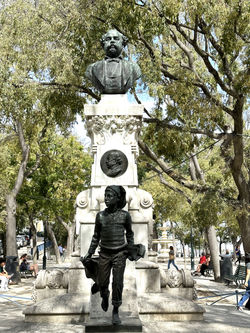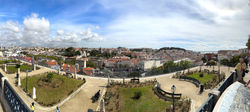
Portugal | Lisbon
 Photo is taken from Parque Eduardo Vll. This is a public park occupying 64 acres in Lisbon's city center. The park is named for King Edward Vll of the United Kingdom, who visited Portugal in 1903 to atrengthen relations between the two countries. |
|---|
 This is a memorial to the Lisbon earthquake of 1755. It was actually a series of earthquakes that occurred on the morning of November 1, 1755, causing serious damage to the port city of Lisbon and killing an estimated 60,000 People in Lisbon alone. Violent shaking demolished large public buildings and about 12,000 dwellings. |
|---|
 Mom, Shannon and Me |
|---|
 The Marques de Pombal was the Prime Minister of King Joseph l from 1750 to 1777. He was in charge of the reconstruction of Lisbon following the earthquake of 1755. He abolished slavery in Portugal, reorganized the educational system and published a new Penal code. His reforms faced opposition from the Jesuits and the aristocracy. After King Joseph died he was accused of abuse of power. |
|---|
 Beautiful green areas around the city |
|---|
 View of the Castle of St George |
|---|
 Another view to the river from the park |  View from the top |
|---|
 The colors in Portugal displayed on their buildings and houses in particular are more muted than those that you see in neighboring Spain. |
|---|
 The bust displayed here is a tribute to Eduard Coelho, founder in 1864 and publisher of the popular newspaper Diario de Noticias. |  Panoramic view from the park |
|---|
 The Church of St Vincent |
|---|
This church is dedicated to St Vincent of Saragossa, patron saint of Lisbon, whose relics were brought from the Algarve to Lisbon in the 12th century. The present buildings are the result of a reconstruction ordered by King Philip ll of Spain, who had become King of Portugal (as Philip l) after a succession crisis in 1580. The church was built between 1582 and 1629. The beautiful main altarpiece is a Baroque work of the 18th century by one of the best Portuguese sculptors, Joachim Machado de Castro. It has the shape of a baldachin and is decorated with a large number of statues. The church also boasts several fine altarpieces in the lateral chapels.
 Inside St Vincent's |  More inside the church |  Main altar in the church |
|---|---|---|
 Stained glass |  A side altar |  The Pieta in the interior of the Cathedral |
 The Baptismal Font |
 This is a summer palace built in Cascais in the late 19th and early 20th centuries when the region became a popular resort destination for the Portuguese royal family and Portuguese aristocracy. Sea bathing was already becoming popular in the mid-1850's and Cascais with its protected beaches attracted the royal family and nobility from Lisbon. The area is still home to many wealthy people and is an expensive place to live. |
|---|
 Beautiful Boulevard in Cascais |  Statue of Dom Pedro l in Cascais |  Paddleboarding class in Cascais |
|---|---|---|
 Town Hall in Cascais |  The marina at Cascais |
 Monument to the International Sailing Federation |  The Tower of Santo Antonio provided protection for the town and the entrance to the river estuary that leads to Lisbon. |  More of Santo Antonio |
|---|---|---|
 Hotel Baia in Cascais |  Cascais City Hall |
 The Church of Our Lady of the Navigators was originally known as the Church of the Men of the Sea.This edifice had its origins in a primitive chapel, already in existence in the 16th century on the same site, which was dedicated to Our Lady of Help. It withstood the great earthquake of 1755. |
|---|
 Sardines Anyone?? |  Pasteis de Bacalhau are codfish cakes or or salt cod fritters and are a an icon of the Portuguese cuisine.They are deep fried fish cakes which are traditionally made from a combination of mashed potatoes, shredded salt cod, eggs, onion and parsley. They are wonderful served with the incredible port wine made in Portugal. |
|---|
For centuries the sardine has played an important part in Portuguese eating habits. Traditionally they were associated with the lower classes, who would rub this fatty fish on bread to increase the flavor and "make the fish last longer". Nowadays sardines continue to be one of the most affordable fishes in Portugal but they are considered a delicacy and appreciated by all. Canned sardines is another creative example of how this fish is so widely loved by the Portuguese people. These beautiful cans have also become a collectors item as well as a great gift idea for anyone who wants to share this gourmet tradition.
 The streets of Cascais |  The side of a Bank building in Cascais |  Mosaic walkways in Cascais |
|---|
 The Cabo da Roca Lighthouse is a beacon/lighthouse located 541 feet above the Atlantic Ocean on continental Europe's most westerly extent. It originally began operating in 1772 and is the third oldest operating lighthouse along the Portuguese coast. |  View of the beach below the lighthouse |  Cabo Da Roca - most Western Point in Continental Europe |
|---|---|---|
 Hell's Mouth or the Boca de Inferno is a unique sea arch and cliff formation along the Costa de Guia, to the northwest of Cascais. It was originally a sea cave that collapsed, leaving a chasm and sea arch. Into this opening the powerful Atlantic waves continually crash, and during violent winter storms water explodes upwards, similar to an erupting volcano. |
 Pasteis de Belem are cream tartlets made according to a secret recipe that has not been revealed in almost two hundred years and that, supposedly, only seven people know on the planet. It is one of the most characteristic specialties of Portuguese cuisine.It is believed that the old recipe came from the Jeronimo's monastery. Since 1837 the Casa Pateis de Belem pastry shop has been working uninterruptedly both for the sale and consumption of the cakes. |  Making our purchase |  Burger King in Belem |
|---|
 Jeronimo's Monastery of Santa Maria de Belem is a former monastery of the order of St Jerome. In the monastery there are the tombs of navigator Vasco de Gama and poet Luis de Camoes and the monastery itself symbolizes the Portuguese Age of Exploration. |  The Belem Tower is an old military construction located in the city of Lisbon. It is a work by Francisco de Aruda and Diogo de Boitaca and served as a fortress and a port from where Portuguese explorers set out to establish the first European trade in history, with China and India. |  This monument was built in 1960 on the banks of the Tagus River in Lisbon to commemorate the 500 years of the death of Henry the Navigator. It celebrates sailors, royal patrons and all those who participated in the development of the Age of Discoveries. |
|---|---|---|
 At the front of the sculpted monument |  Luis de Camoes - Poet |  Filipa de Lancastre was the first born daughter of the first Duke of Lancaster and his first wife. When she was 18 she was awarded the Most Noble Order of the Garter, which years later would contribute to her image of a holy queen. She became queen of Portugal thanks to her marriage to John l of Portugal, celebrated in 1387 in the city of Porto. She was a generous queen loved by her people. |
Luis de Camoes is generally believed to be the greatest poet in the Portuguese language. He led a turbulent and bohemian life style and was exiled in 1546 due to a love affair. In 1547 he began his military career and in 1550 he returned to Lisbon where he was imprisoned for a street brawl. He achieved freedom 3 years later and embarked to India. He was sent to Macau but in 1558 was accused of extortion and returned to India. He survived a shipwreck and returned to Portugal, via Mozambique, in 1570, with a manuscript of his epic poem intact. It was published two years later.
 Daniela grew up in the city of Porto and was truly a wealth of knowledge on what we should see and do when we visited there. |  Me, Mom and Joao (John) |
|---|
 The National Palace of Sintra is located in the center of Sintra and defines the landscape with its unmistakable sillouette formed by its two conical chimneys crowning the royal kitchen. It is the only palace that spans the entire history of Portugal. |  Fireplace with mosaic surround |  Bedroom in the palace - look at the size of the door |
|---|---|---|
 Restoration work in the palace |  The Palace Kitchen |  Kitchen Utensils |
 A Ceiling in the Palace |  Lots of beautiful mosaics |  Palace chandelier |
 Another beautiful ceiling |  A massive room |  Bathroom in the Palace |
 The streets of Sintra, Portugal |  Entering the Pena Palace grounds in Sintra, Portugal |  Entrance to the Pena Palace |
|---|---|---|
 Façade of the Pena Palace |  Brilliant yellow against the blue sky |  An entrance |
 Outside terrace area |  Palace window |  A view from the palace |
The history of the Pena Palace or National Palace of the Feather is extraordinary. In 1836, Queen Mary ll of Portugal married the future Ferdinand ll of Portugal, who became the Portuguese monarch because of his wife. Shortly after his arrival in the country he began to acquire lands in the Sintra area due to the fascination the area produced in him after an excursion with his wife. Finally the aristocrat's admiration for this area prompted him to build a palace. It became an exuberant venue of different styles ranging from neo-Gothic to Neo-Islamic, passing through Neo-Renaissance and a pseudo-Manuelin vision that turn the space into a clearly exotic environment. He also built a magnificent English park on the slopes of the mountain, collecting flora and fauna from all over the world. Queen Mary ll died in 1853 during the birth of her 11th child. After her death her husband Ferdinand remarried the opera singer, Elsa Hensler, countess of Edla. The history of the royals who lived here would be a story worth your exploration.
 Many different mosaics adorn the palace |  Stained glass inside |  The chapel in the Pena Palace survived the earthquake of 1755 intact and showcases a magnificent alabaster altarpiece attributed to Nicolas Chanterenne. |
|---|---|---|
 Mosaic detail in the palace |  The awe inspiring Pena Palace |  The towers of the palace iffer expansive views of the countryside |
 The Castle of the Moors was erected on a rocky massif and is isolated on one of the peaks of the Sintra Mountain Range. Muslims were responsible for the first fortification, between the 8th and the 9th century, whose purpose was to strategically control the land routes that linked Sintra with Mafra, Cascais and Lisbon. |
 The wind catching Shannon's hair at the palace |  Striking a pose in the the turret |  Views from the palace |
|---|---|---|
 The gardens of the Pena Palace |  In the Hydrangea Garden |
 At the lake |  A Swan |  In the Fern Garden |
|---|---|---|
 A Meandering Path through the Gardens |  More of the gardens |  Monument to Ferdinand ll in the park. The park consists of forest and lush gardens with more than five hundred different species of trees from the four corners of the earth. |
 The end of the trail |
 In Sintra you will find both Piriquita and Piriquita ll. They both contain the most wonderful sweet treats. Piriquita ll can be found further up the hill and because of that is generally a little les crowded. |  Sweet treats at Piriquita ll |
|---|
 Newfound friends in Lisbon |
|---|